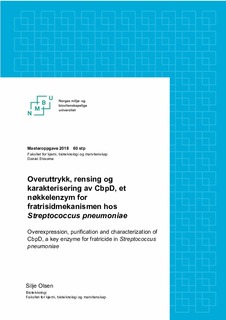| dc.contributor.advisor | Straume, Daniel | |
| dc.contributor.advisor | Håvarstein, Leif Sigve | |
| dc.contributor.author | Olsen, Silje | |
| dc.date.accessioned | 2018-09-10T11:44:41Z | |
| dc.date.available | 2018-09-10T11:44:41Z | |
| dc.date.issued | 2018 | |
| dc.identifier.uri | http://hdl.handle.net/11250/2561767 | |
| dc.description.abstract | Streptococcus pneumoniae er en viktig humanpatogen bakterie, som har evnen til å bli kompetent for naturlig genetisk transformasjon. Dette gjør at den kan ta opp nakent DNA fra omgivelsene og inkorporere det i sitt eget genom via homolog rekombinasjon. Å kunne bli kompetent for naturlig genetisk transformasjon har vært, og er en viktig drivkraft for evolusjonen til S. pneumoniae. Naturlig genetisk transformasjon er nært knyttet til fratrisidmekanismen hos S. pneumoniae. Fratrisidmekanismen, også kalt brodermord, går ut på at kompetente pneumokokker lyserer andre ikke-kompetente pneumokokker og nært beslektede streptokokker. Når målcellene lyserer, lekker det ut DNA til omgivelsene som de kompetente angripercellene kan ta opp via naturlig genetisk transformasjon. Fratrisid antas å være viktig for at pneumokokkene skal få tilgang på homologt DNA, og at de dermed kan erverve nye fordelaktige egenskaper, som penicillinresistens og virulensfaktorer.
For å få tilgang på homologt DNA produserer kompetente pneumokokker celleveggshydrolasen CbpD, som binder til og lyserer ikke-kompetente streptokokker. De kompetente pneumokokkene er derimot selv immune mot CbpD som produseres. Siden S. pneumoniae forårsaker mange dødsfall hvert år på grunn av dens virulente egenskaper, og siden antall penicillinresistente isolater øker, er det viktig å få en fundamental forståelse av hvordan disse genene spres mellom streptokokker. På grunn av at CbpD er en essensiell komponent i fratrisid, og dermed gir tilgang på homologt DNA, har vi i dette arbeidet forsøkt å finne ut mer om de biokjemiske egenskapene til dette enzymet, samt dets målgruppe.
Tidligere er det forsøkt å rense CbpD fra S. pneumoniae (CbpDSpn), men dette ble mislykket. I dette arbeidet overuttrykket og renset vi derfor CbpD fra S. mitis og fra S. oralis, som er CbpDSpn-homologer. Vi klarte å holde CbpD fra S. mitis stabilt, samt å finne en god oppbevaringsmetode for proteinet, noe som er viktig for videre analyser. Eksperimenter utført i dette arbeidet viser at S. pneumoniae danner immunitet mot CbpD fra både S. mitis og S. oralis, og i tillegg er de immune over flere generasjoner. Vi viste også at lysering forårsaket av CbpD er doseringsavhengig, og at CbpD lyserer flere streptokokkarter. Vi klarte derimot ikke å finne hvor i peptidoglykanet CbpD kutter, eller å løse dets 3D-struktur. | nb_NO |
| dc.description.abstract | Streptococcus pneumoniae is an important human pathogenic bacterium, which has the ability to become competent for natural genetic transformation. This allows the bacterium to take up naked DNA from the environment and incorporate the DNA into its own genome via homologous recombination. Being competent for natural genetic transformation is a major driving force for the evolution of S. pneumoniae. Natural genetic transformation is closely connected to the fratricide mechanism in S. pneumoniae. The fratricide mechanism makes it possible for competent pneumococci to lyse and kill other non-competent pneumococci and closely related streptococci. When the target cells lyse, DNA leaks to the environment for the competent attacker cells to take up, through natural genetic transformation. Fratricide is thought to be important for the pneumococci to gain access to homologous DNA, and thereby obtain new beneficial properties, such as penicillin resistance and virulence factors.
In order to gain access to homologous DNA, competent pneumococci produce the cell wall hydrolase CbpD, which binds to and lyses non-competent sister cells. The competent pneumococci are, however, immune against CbpD that are produced. Since S. pneumoniae causes many deaths each year because of its virulent factors, and since the number of penicillin resistant isolates increases, it is important to gain a fundamental understanding of how these genes spread between streptococci. Because CbpD is an essential component of fratricide, hence providing access to homologous DNA, we have tried to find out more about the biochemical properties of this enzyme, and its target range of streptococci.
Previously, it has been attempted to purify CbpD from S. pneumoniae (CbpDSpn), but this was unsuccessful. In this study, we therefore overexpressed and purified CbpD from S. mitis and from S. oralis, which are CbpDSpn homologues. We managed to keep CbpD purified from S. mitis stable, and found a suitable storage condition for the protein, which is important for further analyses. Experiments performed in this study, show that cells of S. pneumoniae are immune against CbpD produced by both S. mitis and S. oralis, and also, they are immune for several generations. We showed that lysis caused by CbpD is dose dependent, and that CbpD lyses several streptococcal species. We did not, however, find which bond in the peptidoglycan CbpD cuts. Neither did we solve the 3D-structure of CbpD. | nb_NO |
| dc.language.iso | nob | nb_NO |
| dc.publisher | Norwegian University of Life Sciences, Ås | nb_NO |
| dc.rights | Attribution-NonCommercial-NoDerivatives 4.0 Internasjonal | * |
| dc.rights.uri | http://creativecommons.org/licenses/by-nc-nd/4.0/deed.no | * |
| dc.subject | Streptococcus pneumoniae | nb_NO |
| dc.subject | Naturlig genetisk transformasjon | nb_NO |
| dc.subject | Fratrisid | nb_NO |
| dc.subject | CbpD | nb_NO |
| dc.title | Overuttrykk, rensing og karakterisering av CbpD : et nøkkelenzym for fratrisidmekanismen hos Streptococcus pneumoniae | nb_NO |
| dc.title.alternative | Overexpression, purification and characterization of CbpD : a key enzyme for fratricide in Streptococcus pneumoniae | nb_NO |
| dc.type | Master thesis | nb_NO |
| dc.description.version | submittedVersion | nb_NO |
| dc.subject.nsi | VDP::Mathematics and natural science: 400 | nb_NO |
| dc.source.pagenumber | 116 | nb_NO |
| dc.description.localcode | M-BIOTEK | nb_NO |

